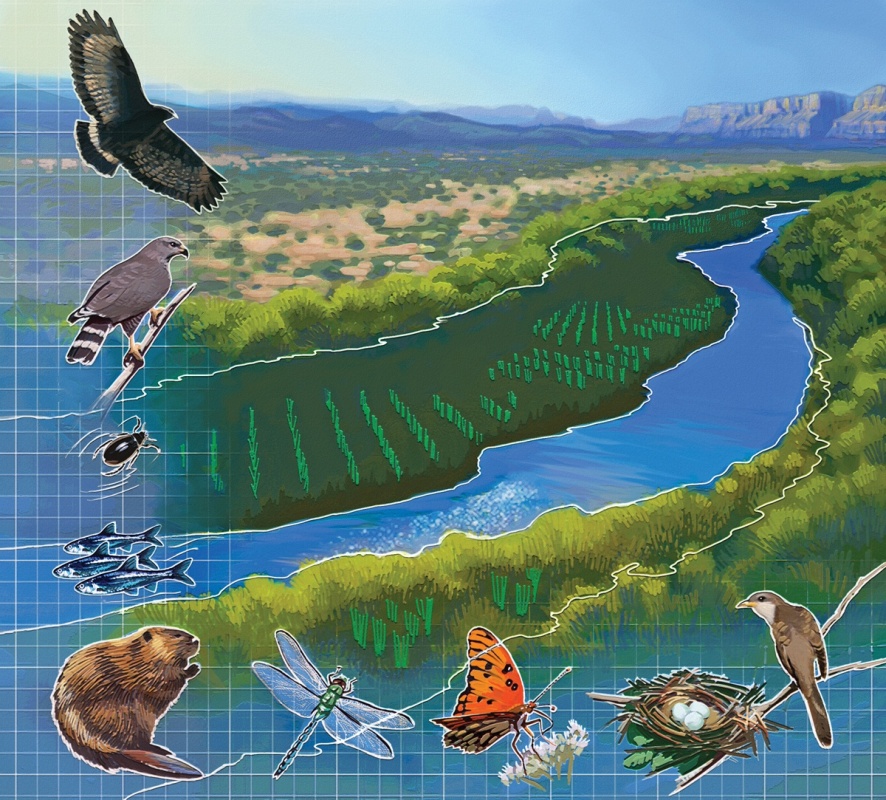The Greek philosopher Heraclitus reasoned 2,500 years ago that everything flows and nothing remains, so no man ever steps into the same river twice.
But we can try.
Among those trying is Jeff Bennett, a physical scientist at Big Bend National Park who specializes in hydrology, the science of how water moves on and under land. He’s working with Mike Montagne, a fish biologist with the U.S. Fish and Wildlife Service at the Texas Fish and Wildlife Conservation Office in San Marcos. Big Bend is in Montagne’s bailiwick. These two, along with other scientists, strive to restore some semblance of what Terlingua Creek was like more than a century ago. They pursue this goal to improve fish and wildlife habitats, some of it essential for the conservation of threatened or endangered bird and fish species.
Terlingua Creek flows south out of the desert canyons in Big Bend National Park, draining a watershed of 1,100 square miles, an area slightly smaller than Rhode Island. It is a wild and remote piece of the national park system. Yet the remoteness didn’t save the streamside woodlands more than a century ago. Now almost treeless, Terlingua Creek once teemed with wildlife, its water purling through lush cottonwood and willow galleries that lined its course. The water remained hidden from the blistering sun, cooled by the shade and slowed by beaver dams as it poured toward the Rio Grande.
Then everything changed. The trees were harvested for firewood to fuel nearby mining operations. That altered the creek’s course and disturbed its hydrology to the point that the trees did not reproduce. The stream became unsteady and prone to flash flooding, with the water unshaded and no longer suitable for fish. Now, permanently flowing water appears in only about 40 percent of the 84-mile-long creek.
To make Terlingua Creek more hospitable for fish and wildlife, Bennett and Montagne copied nature by planting scads of willow poles two years ago. “In our first phase, we stuck 1,800 willows in 5 acres of gravel beds—deep, so that they would stay wet and root first then leaf out,” Bennett said.
The willow poles were harvested from existing stands within the Terlingua Creek watershed and nearby Rio Grande and planted in diamond-shaped patterns with a “spear” pointed upstream. “The shape mimics how groups of plants naturally arrange themselves against flowing water,” Bennett noted. “It seems to be working—the willows are 5 feet tall, green and happy, and catching sediment. That stabilizes the stream bank. The trees slow water movement; they’re like a sponge, sending more water to storage underground.”
Underground is where you will find tree roots. These 5 acres, along with the stands still to be planted, are future habitats for endangered birds, such as the yellow-billed cuckoo. It’s a bird that nests in stands of established streamside willows and cottonwoods. Gray hawks and common black hawks also will take to galleries of willows and cottonwoods. Cottonwood trees are expected to recolonize naturally in the protection of the new willow stands.
Another element of this conservation endeavor is expanding habitat for the endangered Rio Grande silvery minnow. The small fish once swam along the expansive reach of its namesake river and nearby tributaries. In Texas, the Rio Grande silvery minnow populates the river in Big Bend. The silvery fish are there because of releases from the Uvalde National Fish Hatchery, and building more habitats is an essential conservation measure.
The Rio Grande basin is a concentrated area of emphasis for the U.S. Fish and Wildlife Service, which helps fund the Terlingua Creek restoration work. Montagne and staff have been in the water monitoring fish populations, measuring physical changes in the creek’s structure and surveying differences in aquatic bugs as bellwether signs of water quality. Aquatic insect populations are important as food for fish and birds.
To take the Rio Grande silvery minnow off the endangered species list, some work needs doing, Montagne said. “Three separate, distinct, self-supporting populations of silvery minnows need to be established to downlist the fish. This site around Terlingua Creek and the Rio Grande in Big Bend is No. 2,” said Montagne. “We planted silvery minnow in Big Bend from 2008 to 2012, and more fish came last fall.”
If anything is certain in the natural world, it is impermanence. Even though Terlingua Creek will not soon offer the pristine waters and wildlife habitat of the time when cottonwoods towered over its banks more than a century ago, the partnership between the National Park Service and Fish and Wildlife Service moves that goal closer.
With perseverance and improved habitats, the streamside trees will return, the Rio Grande silvery minnow will swim its waters, and the imperiled birds will return each spring to nest and fledge once again.
——————–
Craig Springer works with the U.S. Fish and Wildlife Service in the Southwest Region office in Albuquerque, New Mexico.


